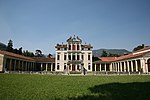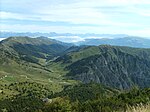Museo Civico di Bassano
Art museums and galleries established in 1840Art museums and galleries in VenetoItalian museum stubsMonasteries in VenetoMuseums in Veneto

The Museo Civico di Bassano del Grappa is the town art and architecture museum located on Piazza Garibaldi #34 in Bassano del Grappa, in the Vicenza province of the region of the Veneto, in northern Italy. It is housed in a former Franciscan convent.
Excerpt from the Wikipedia article Museo Civico di Bassano (License: CC BY-SA 3.0, Authors, Images).Museo Civico di Bassano
Piazza Giuseppe Garibaldi,
Geographical coordinates (GPS) Address External links Nearby Places Show on map
Geographical coordinates (GPS)
| Latitude | Longitude |
|---|---|
| N 45.7664 ° | E 11.7352 ° |
Address
Museo Civico
Piazza Giuseppe Garibaldi
36061
Veneto, Italy
Open on Google Maps







